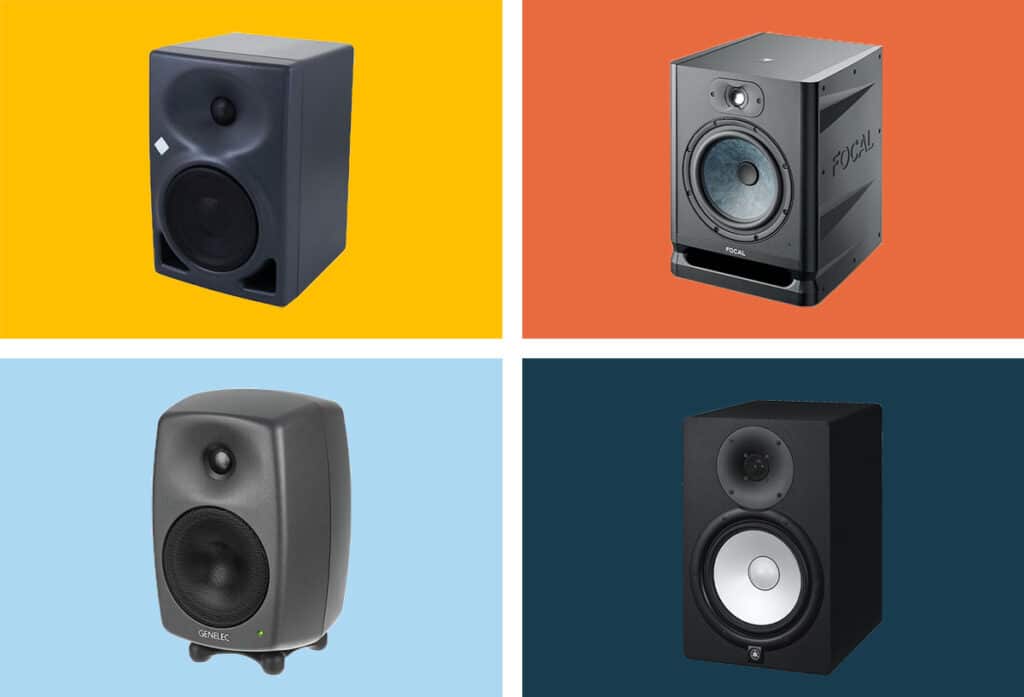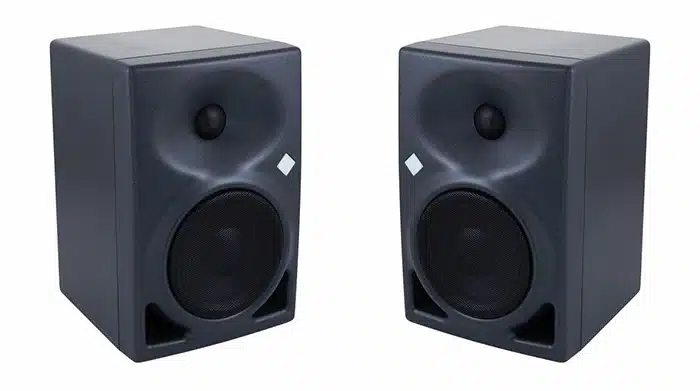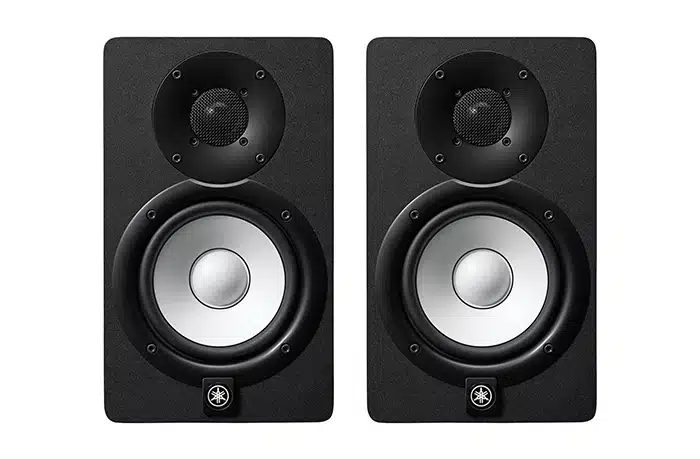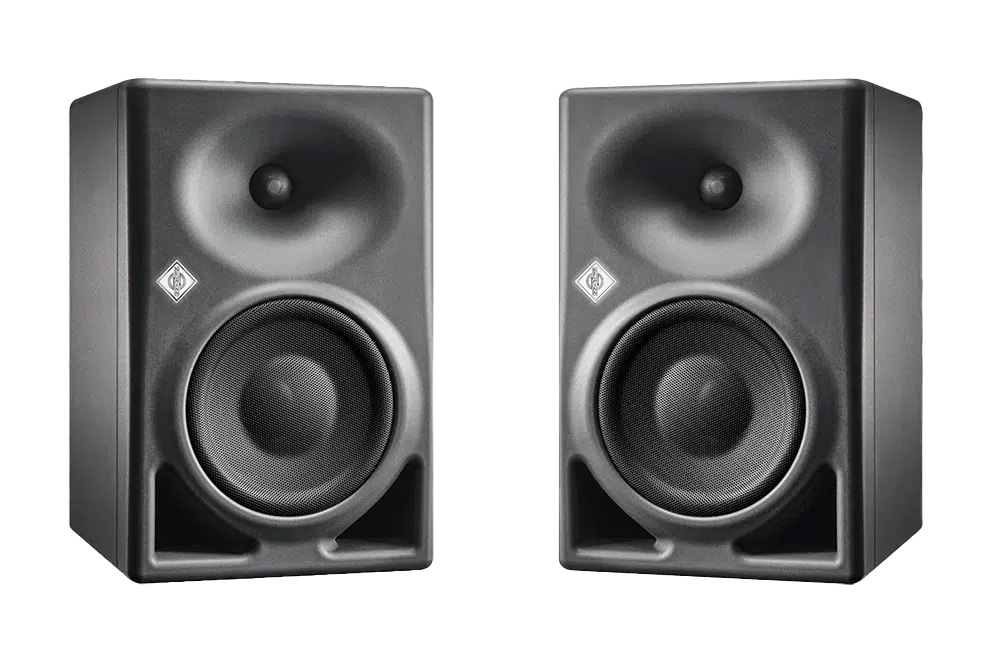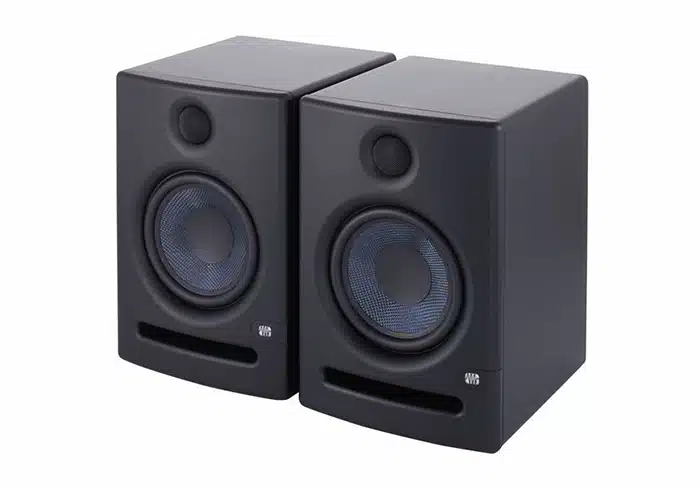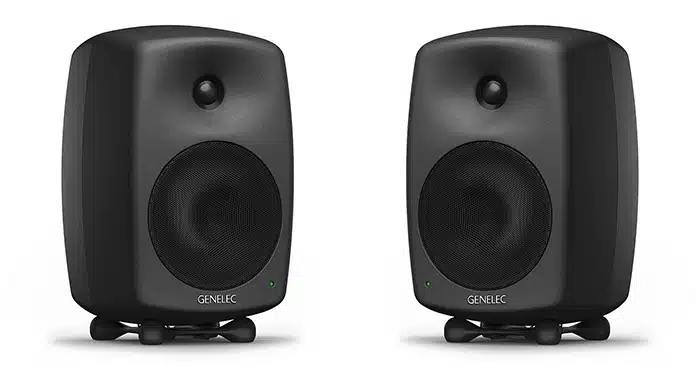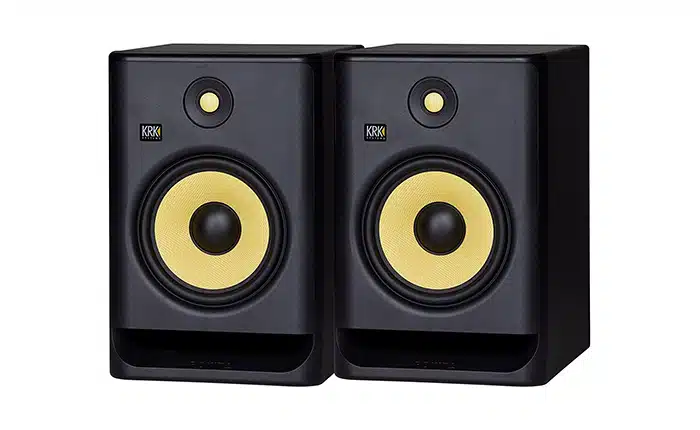Studio monitors are a very important topic when it comes to studio equipment. In fact, I would say that studio monitors are the most important piece of equipment in a recording studio.
That's why some studios spend more than $100,000 on monitors! Because without a perfectly balanced and clean sound, you can't make good production/mixing/mastering decisions.
The best studio monitors allow you to hear the flaws in the mix so that you can manipulate the various parameters more effectively and get a better result than you would with ordinary consumer speakers or headphones.
For home recording and home studios, active near-field monitors are the best studio monitors you can buy. They are best placed on a dedicated console, shelf, or stand near the mixer.
For professional studios, important considerations such as room size, speaker frequency response, budget, and long-term reliability should be taken into account when selecting studio monitors.
High-end speakers are recommended for those who spend long hours in the recording studio, as they allow for long mixing sessions without strain on the ears. They deliver a transparent sound you can rely on and are extremely durable.
For occasional use and semi-professional or amateur productions, cheaper entry-level monitor speakers are more suitable. The sound is not as transparent as more expensive models, but once you get used to it and know the sound well, you can mix and master with it without any problems.
Below you'll find our rankings of the best studio monitors in every price range, from high-end to low-budget. We've also included descriptions of the most important features.
Are you looking for headphones for your studio? Here I compare my 8 favorites.
In short:
- The Neumann KH120 are the best studio monitors for a budget of just over $1,000. They deliver a crystal-clear, defined sound that is unrivaled at this price point.
- For smaller budgets, the Yamaha HS8s are recommended because they sound incredibly neutral and have a very balanced frequency response.
- If money is not a concern, we recommend the new Neumann KH-150.
The best studio monitors
1. Neumann KH120 - Best studio monitors
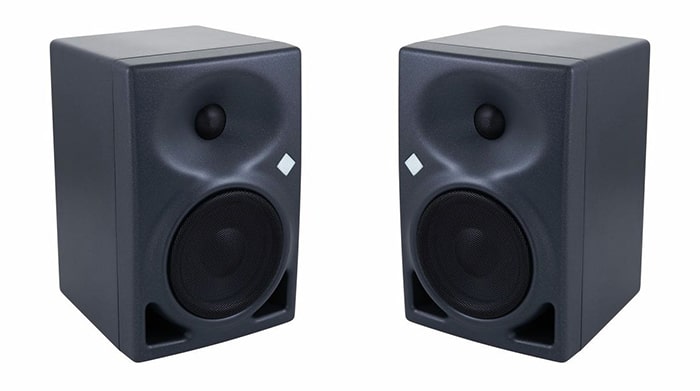
TECHNICAL SPECS
Frequency range: 52 Hz - 21 kHz
Configuration: 2-way nearfield monitor
Membrane sizes: 5.25" woofer + 1" tweeter
Power: 50 W woofer and 50 W tweeter
Digital connections: No
Weight: 2 x 6,2 kg
MODELS / PRICES
Neumann KH 120 A (649€)
ARGUMENTS IN FAVOR
- High End Monitors
- Neutral frequency response, so you can trust these monitors
- Incredible detail and impulse fidelity
NEGATIVE POINTS
- Not cheap
Buying these studio monitors was a turning point in my career as a sound engineer - the sound of these speakers is truly fantastic. When you try them for the first time (and if you've only tried cheaper models), you understand why high-end audio is called "high-end" - because you hear high frequencies that you've never heard with other speakers.
The KH 120 is one of the most honest sounding monitors in its price range. You can really hear every little detail, all instruments have their place in the mix and you can distinguish them very well (very good depth).
These studio monitors from Neumann consist of a 5.25" woofer + 1" tweeter. The frequency response breaks off at about 60 Hz in the bass range, and at about 52 Hz the level should be only 3 dB below, which is quite good for such small monitors.
Neumann has equipped the KH 120 with a Mathematically Modeled Dispersion™ Waveguide. As a result, the speakers provide more accurate sound distribution, both horizontally and vertically.
The sound is precisely expanded horizontally, giving you more flexibility in your listening position (I don't have to be exactly in the center of the triangle to get the perfect stereo image). Vertically, however, the dispersion is limited, so that reflections in the near environment (table, mixer, ceiling) are reduced. Ingenious!
These are my main monitors for mixing and mastering at the moment. To be fair, these monitors don't go that deep because they only have a 5.25" woofer. Surprisingly, the bass is still very audible and the mixes transfer very well even to larger systems. So you can really rely on these monitors.
But I also use my Focal Alpha 65 from time to time, especially when I want to edit the bass track individually or while recording bass.
2. Yamaha HS8: Best studio monitors for semi-professional use
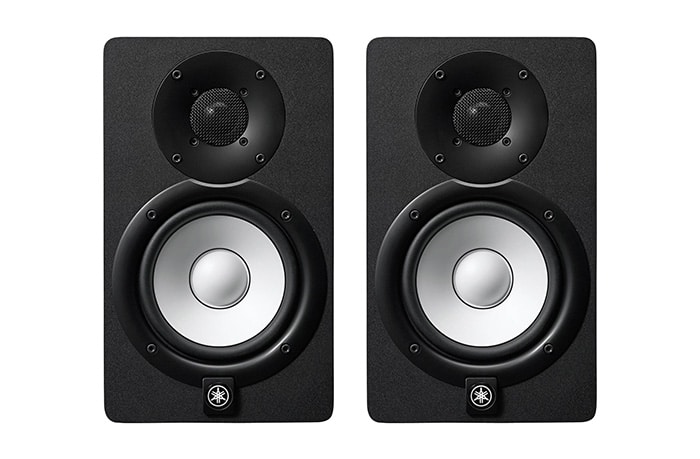
TECHNICAL SPECS
Frequency range: 38 Hz - 30,000 Hz
Configuration: 2-way nearfield monitor
Membrane sizes: 8" woofer + 1" tweeter
Power: 75 W woofer and 45 W tweeter
Digital connections: No
Weight: 2 x 10.2 kg
MODELS / PRICES
Yamaha HS8 (296€)
ARGUMENTS IN FAVOR
- Very honest & trustworthy sound
- Good low end
- Perfect for mixing and mastering
NEGATIVE POINTS
- If you prefer bass-heavy studio monitors, there are better alternatives.
If you're looking for compact studio or home recording monitors that, like the classic NS10s, pick up all the irregularities and details of music mixing, look no further than the Yamaha HS8.
As with the NS10s, you will love - and sometimes hate - the honesty of these speakers, because they are way too honest! Especially when you compare them to, say, KRK speakers, which are much more bass-heavy. But the sonic results of these monitors are truly exceptional, especially considering how affordable they are.
I would recommend these studio monitors to anyone who wants to mix and master, because only with a transparent and pristine sound you can make the right decisions. For DJs or EDM producers, however, the speakers might not have enough bass, so the KRK Rokit RP8 would be better suited.
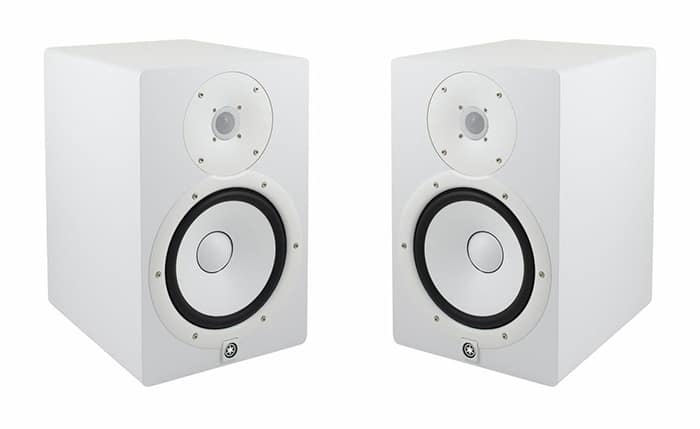
Each active bi-amplified speaker consists of an 8″ woofer, a 1″ tweeter and a bass reflex port on the back. These studio monitors are not well suited for small rooms, but are best used in rooms with plenty of room and optimal acoustics, as the 8″ woofer can get quite loud.
They have a good frequency response (38Hz - 30kHz) and are pre-amplified for a total output of 120 watts per pair.
If you place the speakers near a wall, you can use the selector switch on the rear panel to activate the Room Control function to reduce the power of the low frequencies. You can also use the High Trim option to boost or cut the high frequencies by 2 dB.
If these active nearfield monitors are too big or too expensive, check out their little brothers, the Yamaha HS5 (5" woofer) and the Yamaha HS7 (6.5" woofer). They are also very transparent and sound very good. The sonic difference to the HS8 is that the smaller speakers don't go as low (HS7 down to 43 Hz, HS5 down to 54 Hz).
3. KRK Rokit RP8 G4 - Best Studio Monitors for EDM/Trap Producers

TECHNICAL SPECS
Frequency range: 36 Hz - 40,000 Hz
Configuration: 2-way nearfield monitor
Membrane sizes: 8" woofer + 1" tweeter
Power: 135 W woofer and 68 W tweeter
Digital connections: No
Weight: 2 x 10,25 kg
MODELS / PRICES
KRK Rokit RP8 G4 (229€)
ARGUMENTS IN FAVOR
- Music is very bass-heavy, which makes it more enjoyable to listen to
- Well suited for DJs
- Room correction using the built-in EQ
NEGATIVE POINTS
- Not transparent
- Therefore not optimal for mixing & mastering
The KRK Rokit GP8s are the opposite of the Yamaha monitors: the Yamaha speakers are very neutral, natural and unadulterated - the Rokit are not neutral and have a boost in the low-mid range.
Comparing the two speakers directly, you might think that the KRKs sound better. This is due to the boost in the low-mid range.
However, this boost can cause your mixes to sound too weak in this area, as you will naturally try to compensate for this when mixing. Therefore, mixing and mastering with these speakers is only possible if you know them very well and know how other professionally mixed songs sound through these studio monitors.
But if you're just composing music or you're a DJ and you don't need to master songs, I would recommend the KRK Rokit RP8 G4 in a heartbeat! It's really fun to listen to music with these speakers.
The new version of the G4 Series features Kevlar woofers and tweeters, both in yellow to identify the brand, and a bass-reflex port on the front, which is handy when we want to place the monitors close to the wall.
Both speakers have an internal Class D amplifier and weigh 10.25 kg. The base is made of non-slip material for better grip on a desk or tabletop.
The KRK Rokit GP8 has a frequency response of 36Hz - 40KHz, 203 watts of output power, and accepts balanced TRS/XLR inputs.
Installation is the most important part of a studio monitor. To achieve the most neutral sound possible in any room, the Rokit RP8s hide a small LCD display on the back that provides useful information about the sound control. The side button allows you to select different combinations and tune the EQ of the monitor to perfection.
4. Genelec 8040: Best studio monitors for big budgets
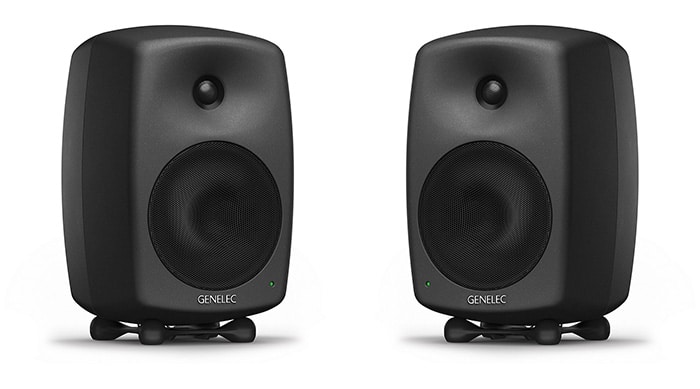
TECHNICAL SPECS
Frequency range: 45 Hz - 20,000 Hz
Configuration: 2-way nearfield monitor
Membrane sizes: 6.5" woofer + 3/4" tweeter
Power: 90 W woofer and 90 W tweeter
Digital connections: No
Weight: 2 x 8,6 kg
MODELS / PRICES
Genelec 8040 BPM (915€)
ARGUMENTS IN FAVOR
- Near-perfect sound - powerful bass, clear treble, and incredible accuracy
- Excellent building quality
- Perfect for mixing and mastering
NEGATIVE POINTS
- Not cheap
Genelec is known for making really good studio monitors. And the Genelec 8040 is no exception! They are one of the best studio monitors I have tried for under 1000€.
These studio monitors have super-clear highs (as good as Neumann's) and a strong, powerful low end that is sufficient for mixing and mastering in most genres. The sound is very neutral and balanced, and you hear all the details with high precision.
These speakers have a 6.5" woofer and a 3/4" metal dome tweeter with a total of 180W. The build quality of these speakers is excellent and much better than most other brands.
However, if you are working with very bass-heavy music (EDM, Trap), you might want to add a subwoofer. I highly recommend the Genelec 7040 - the combination with the 8040 is an absolute blast.
As with all Genelec monitors, convenient rubber feet are included for acoustic decoupling from the studio desk/stand.
Overall, I can really recommend these studio monitors to anyone who has a good room and can afford them, because they are not cheap!
5. Adam T7V

TECHNICAL SPECS
Frequency range: 39 Hz - 25,000 Hz
Configuration: 2-way nearfield monitor
Membrane sizes: 7" woofer + 1.9″ U-ART ribbon tweeter
Power: 50 W woofer and 20 W tweeter
Digital connections: No
Weight: 2 x 7.1 kg
MODELS / PRICES
Adam T7V (199€)
ARGUMENTS IN FAVOR
- Very good monitors for relatively little money
- Ears do not get tired with intensive use
NEGATIVE POINTS
- Not as transparent as the Yamaha's
If you're looking for a pair of high-end professional studio monitors that will stand the test of time, have excellent build quality and are ideal for home recording and high-level music production, we recommend the ADAM T7V.
These active studio monitors feature a 7″ woofer and a 1.9″ U-ART ribbon tweeter. The woofer, which covers low and mid frequencies, operates below 2.5 kHz and is driven by a 1.5" coil and a 50W PWM amplifier.
So when we sit in front of these monitors, you can hear even the smallest changes in the mix. These monitors are very detailed.
Another (very) positive feature I noticed during the test is that the ADAM T7V studio monitors do not cause ear fatigue during intensive use. This is partly due to the fact that these speakers use a ribbon tweeter. This is a very important aspect for studio monitors, especially if you do long mixing/mastering sessions in your studio.
Even at very high volumes, the T7V maintains the clarity we expect from a pair of high-end monitors to properly distinguish different musical instruments and create a well-balanced mix.
The frequency response of these monitors is 39 Hz - 25 kHz. They are recommended for all types of music.
6. Neumann KH-150 - The crème de la crème
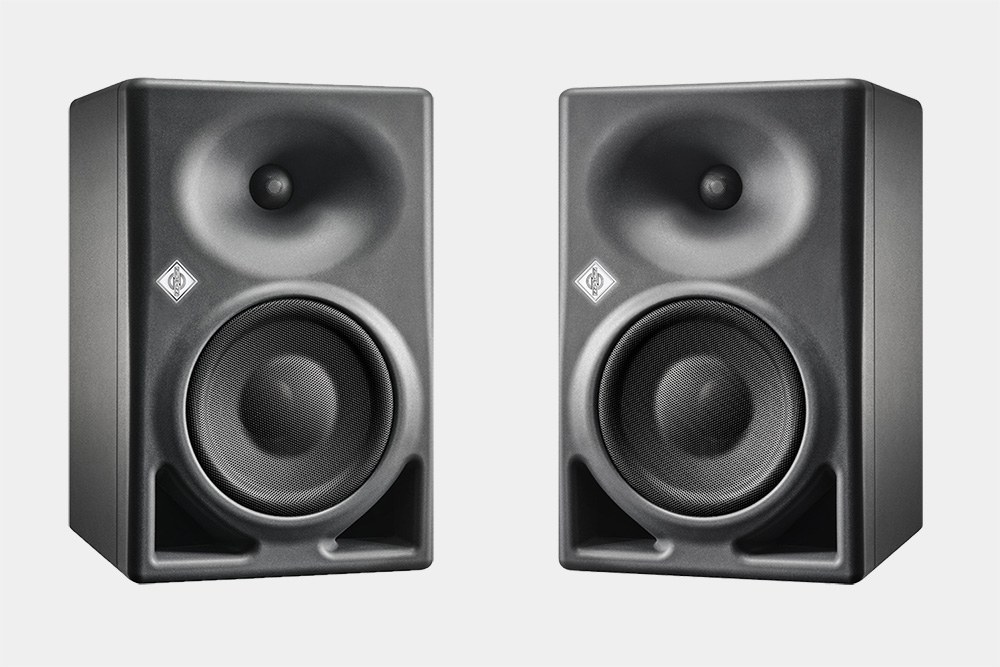
TECHNICAL SPECS
Frequency range: 36 Hz - 21,000 Hz
Configuration: 2-way nearfield monitor
Membrane sizes: 6.5" woofer + 1" tweeter
Power: 145 W woofer and 100 W tweeter
Digital connections: Yes
Weight: 2 x 8 kg
MODELS / PRICES
Neumann KH 150 (1479€)
ARGUMENTS IN FAVOR
- Perfect sound in all aspects
- DSP calibration
NEGATIVE POINTS
- Not cheap
These studio monitors were launched in September 2022 and immediately caused a sensation. They are Neumann's largest 2-way studio monitors to date and feature DSP-controlled electronics. This means that they can be used with the Neumann MA 1 to automatically adapt the sound of the monitors to the room. And it works brilliantly, especially in rooms that are not acoustically treated.
The Neumann KH-150s have a 6.5″ woofer and the same 1″ tweeter as the KH-120, and a total power rating of 245W, so they are very loud. They also have plenty of headroom, which means they sound clear and undistorted even at very high volumes.
The sound of these monitors is a dream - they do everything the KH-120s did, but with a slightly lower frequency response and more precise bass. They are extremely neutral, the bass is punchy but precise and the treble is crystal clear. Surgical processing of audio material is possible with these monitors, and even the finest details are reproduced very accurately.
I really like the high-end frequency response of these speakers, it's incredible what you can hear in songs that you can't hear at all with cheaper monitors - the voice suddenly sounds much more detailed, the hi-hat really stands out in the mix, the snare can suddenly sound completely different, and so on.
I would recommend using these monitors with the Neumann MA 1 - unless you're absolutely sure your studio sounds perfect, then you don't need something like this. But even in my studio, where I've invested several thousand euros in the acoustics, the very low frequencies don't sound perfect, and that can be solved very easily with the DSP calibration.
The speakers are not cheap, however, costing just under €1500 per monitor. But the great features justify the price.
7. Focal Alpha 65 EVO
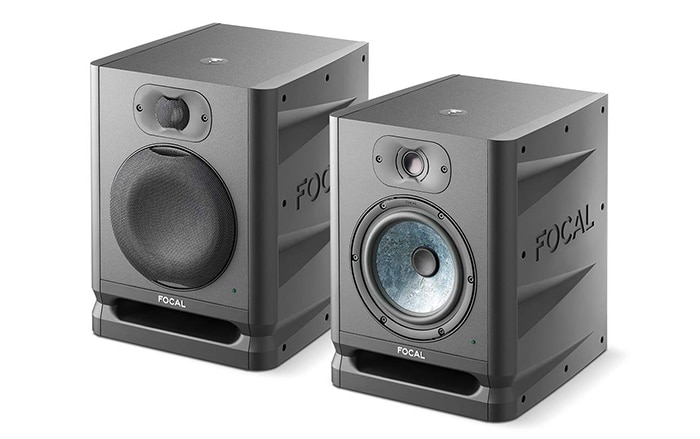
TECHNICAL SPECS
Frequency range: 40 Hz - 22,000 Hz
Configuration: 2-way nearfield monitor
Membrane sizes: 6.5" woofer + 1" tweeter
Power: 55 W woofer and 25 W tweeter
Digital connections: No
Weight: 2 x 7,6 kg
MODELS / PRICES
Focal Alpha 65 Evo (344€)
ARGUMENTS IN FAVOR
- Very good low end
- Well balanced sound
NEGATIVE POINTS
- High frequencies could be clearer
The new Evo Series differs significantly from the previous Alpha Series. It owes its futuristic design to two plastic sides with deep horizontal notches designed to reduce baffle diffraction for a clearer and more precise stereo image. The plastic sides give the Alpha 65 Evo a contemporary look, while the rest of the cabinet is covered in black vinyl.
At the heart of the acoustic design is a 6.5" woofer and a 1" aluminum inverted dome tweeter. The use of the inverted dome is a long-standing Focal tradition, as is the use of metallic materials in the construction.
I have been using these studio monitors for a long time and have always been very satisfied. The bass is clear and loud, and the mix is very balanced and translates well to other systems. The only thing these monitors lack is a little more treble, because you can't hear the very high frequencies as well as you can with Neumann monitors, for example. But the price difference is also huge.
These active studio monitors can get loud, but with good acoustics it's a pleasure to listen to. I would recommend them to anyone. Personally, I use them in addition to my Neumann KH120s, which give me a good balance between high and low frequencies.
8. Genelec 8010: Best portable studio monitors
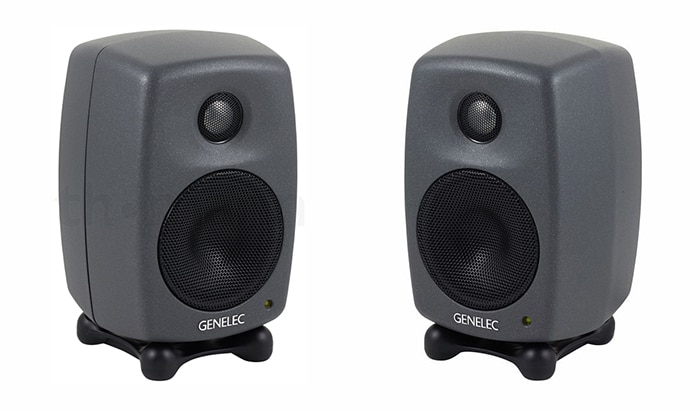
TECHNICAL SPECS
Frequency range: 74 Hz - 20,000 Hz
Configuration: 2-way nearfield monitor
Membrane sizes: 3" woofer + 3/4" tweeter
Power: 25 W woofer and 25 W tweeter
Digital connections: No
Weight: 2 x 1,5 kg
MODELS / PRICES
Genelec 8010 AP (299€)
ARGUMENTS IN FAVOR
- Exceptional portability
- Very good construction quality
- Very good sound for the size
NEGATIVE POINTS
- High price for 3-inch monitors
The Genelec 8010 are the best studio monitors for music producers on the go. These monitors can be easily transported from place to place and stored in a small, lightweight bag.
We have a 3-inch woofer and a .75-inch metal dome tweeter driven by two 25W Class D amplifiers. The crossover is set at 3 kHz.
As with other Genelec speakers, we find a base that allows us to tilt the speakers, while protective grilles serve to protect both the woofer and tweeter from accidents.
Although these are small speakers, you'll find the Genelec quality for which the company is famous, with excellent build quality and very precise sound. Because this is a small and compact model with a woofer that is smaller than other professional studio monitors, you will need to add a dedicated subwoofer for more bass.
In a small hotel room or when traveling, we still find them very useful because we can mix anywhere in a professional way.
Of course, the portability factor and the Genelec brand means that you will pay a higher price than for a more powerful monitor from another brand, but for artists who are constantly on the road, this is one of the few solutions available.
9. PreSonus Eris E5: The best studio monitors for beginners
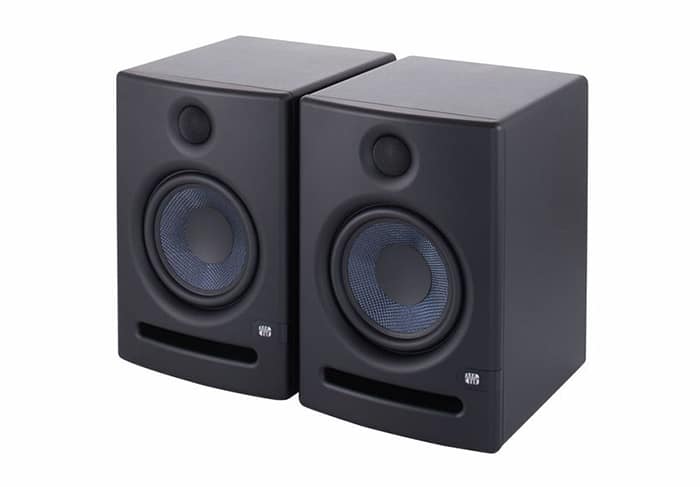
TECHNICAL SPECS
Frequency range: 53 Hz - 22,000 Hz
Configuration: 2-way nearfield monitor
Membrane sizes: 5.25" woofer + 1" tweeter
Power: 45 W woofer and 35 W tweeter
Digital connections: No
Weight: 2 x 4,63 kg
MODELS / PRICES
2x Presonus Eris E5 (206€)
ARGUMENTS IN FAVOR
- An enviable price-performance ratio
- Relatively well balanced sound
NEGATIVE POINTS
- Less faithful reproduction of the original sound than more expensive speakers
The PreSonus Eris E5 studio monitors are a very small investment compared to professional monitors, yet capable of reproducing music honestly and accurately. We recommend them to those who don't have a lot of money to spend on setting up a small recording studio or for home recording.
They feature 5.25-inch woofers and 1-inch dome tweeters with a frequency response of 53 Hz to 22 kHz, and each speaker has two separate amplifiers for low (45 W) and high (35 W) frequencies.
The bass-reflex port on the front of the speaker provides clarity and detail in the low frequencies, and also allows the speaker to be placed close to the wall without much reflection.
The Acoustic Space feature on the back of the monitor helps match the sound to the room and reduces frequencies below 800 Hz. Useful when placing the monitor close to a wall, for example, to avoid bass feedback.
On the other hand, the Cut Off function cuts out the bass frequencies below 100 or 80 Hz, which can be useful if we want to install a subwoofer for these frequencies. The midrange and treble controls are useful for adjusting the volume around 1 kHz and above 10 kHz, respectively.
For the price they are selling for, we cannot find an alternative to these studio monitors. They are truly the best available in the sub-$150 price range.
Still too expensive? Then check out our review of the Swissonic A204BT, studio monitors for 100€/pair.
10. IK Multimedia iLoud Precision MTM
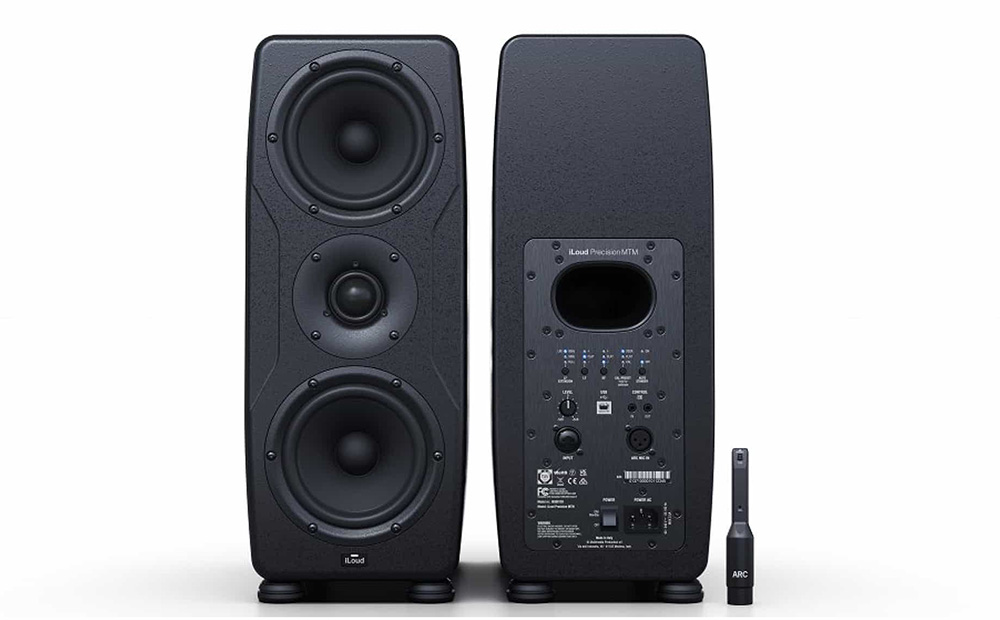
TECHNICAL SPECS
Frequency range: 37 Hz - 30,000 Hz
Configuration: 2-way nearfield monitor
Membrane sizes: 2x 5" woofer + 1,5" tweeter
Power: 175 W
Digital connections: No
Weight: 2 x 11 kg
MODELS / PRICES
IK Multimedia iLoud Precision MTM (1.399€)
ARGUMENTS IN FAVOR
- Neutral and very detailed sound
- DSP calibration
NEGATIVE POINTS
- Not cheap
These studio monitors from IK Multimedia are a bit different because they have 2×5" midrange drivers and 1×1.5" tweeters. They go down to 45Hz and have a very neutral and detailed sound across the spectrum.
They are fully DSP-controlled, with automatic room correction via the included microphones. They come with X-Monitor, a software for Mac and Windows that allows you to do this from your computer. It works very well - it shows you where the acoustical errors are in the room and corrects them automatically.
In addition, the software can emulate the sound of more than 20 popular loudspeakers on the market - a very useful feature for checking the transferability of your production to other monitoring systems.
The transients in music are very audible across the entire spectrum. This is due to the perfectly tuned midrange drivers. These speakers bring out details that other studio monitors miss, especially in dynamics. They can easily compete with much more expensive speakers.
Producers working with a lot of bass-heavy genres may need a subwoofer, as these studio monitors don't go very low. However, the low end is very precise and controlled, and the productions translate well to larger systems.
Frequently asked questions
Do I need an amplifier for my studio monitors?
Passive speakers require an external amplifier, but active studio monitors have an amplifier built in, so they do not require an external amplifier. All studio monitors in this comparison are active and can be connected directly to an audio interface or mixing console.
What is the difference between nearfield monitors and midfield monitors?
As the name implies, active nearfield monitors are placed close to the listening position, about 0.5 m to 1.5 m away. The sweet spot of these speakers is very close, they do not sound good from a distance. However, they are ideal for small studios because they sound very good and are relatively inexpensive compared to midfield monitors.
Midfield monitors are designed to be placed farther away and are usually larger and more expensive than nearfield monitors. They have a wider frequency response and are louder, but require a larger room. This is because the stereo sweet spot is far away, about 2 to 4 meters. They are not as directional as nearfield monitors - so you have a much larger sweet spot to move around in.
Which membrane size is right for me?
The rule is simple: the larger the membrane, the better low-frequency response the loudspeaker will have. So a large diaphragm can reproduce low frequencies better than a small one, which is why 8″ is the most popular woofer size for recording studios.
For accurate reproduction of very low frequencies, a subwoofer is always required - these can be 8″ to 12″ in size and can operate down to 20 Hz. Some expensive midfield monitors have a built-in subwoofer.
But you don't necessarily need a subwoofer or monitors with large diaphragms - even smaller speakers like the Neumann KH120 deliver optimal, balanced sound and can reproduce low frequencies quite accurately (but you don't "feel" the pressure of the bass like you do with a subwoofer).
Where should the studio monitors be placed in the room?
The farther away from the wall, the better, as this prevents sound from reflecting off the back wall. If there is no other option, you can place it directly against the wall, but then you should definitely improve the room acoustics with sound-absorbing materials.
The studio monitors should form an equilateral triangle with the listening position, i.e. the distance between the speakers should be the same as the distance between the listening position and the speakers.
How do I connect my studio monitors to my interface?
Studio monitors are easily connected to an audio interface or mixing console using jack or XLR cables. When using jack cables, always use balanced cables to avoid possible interference.





